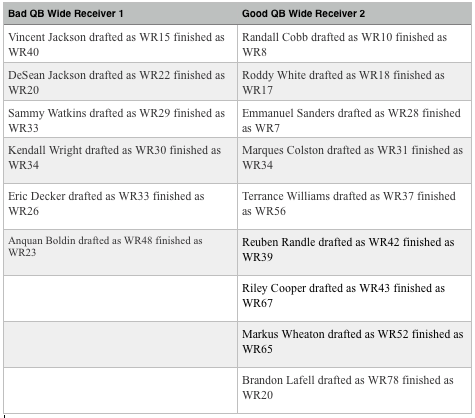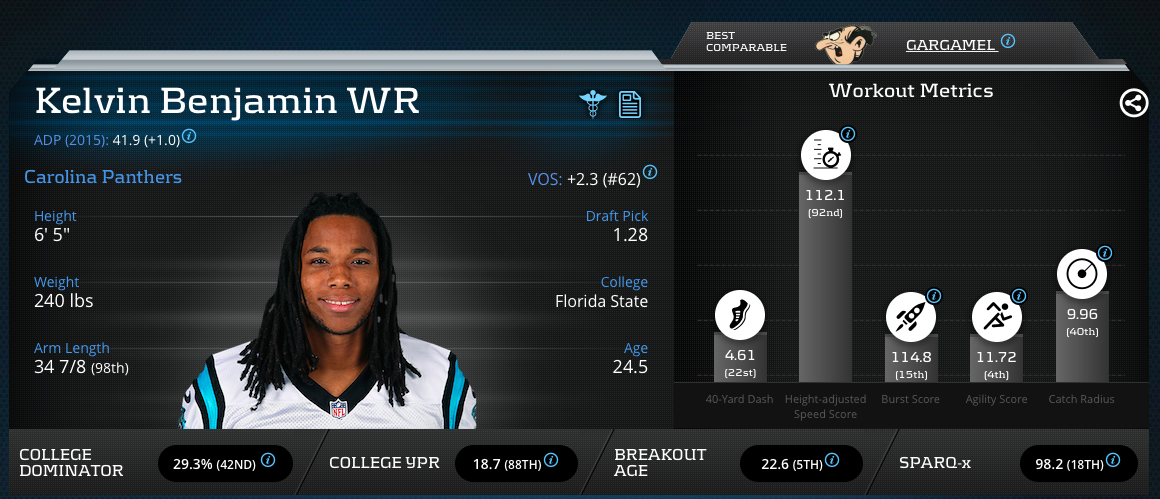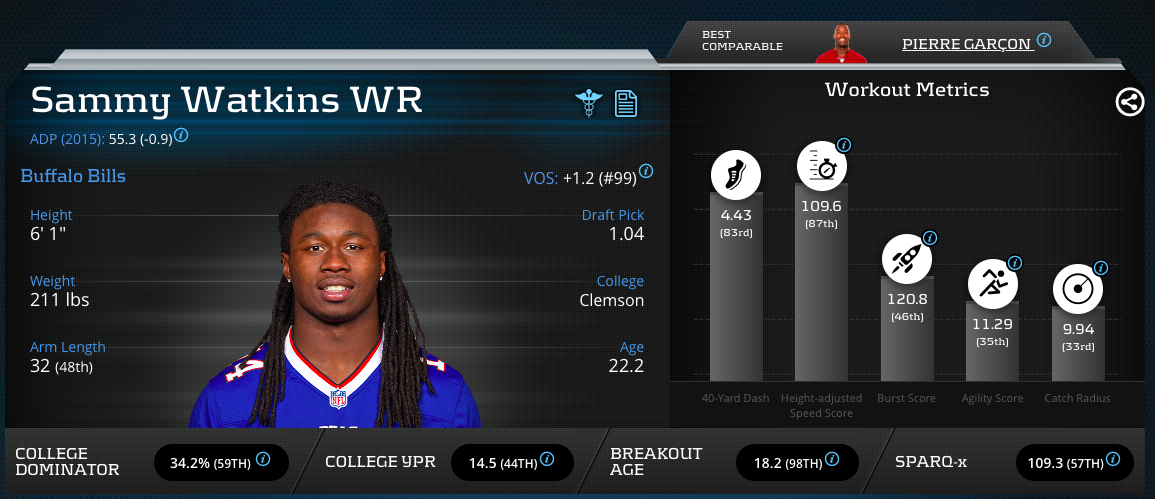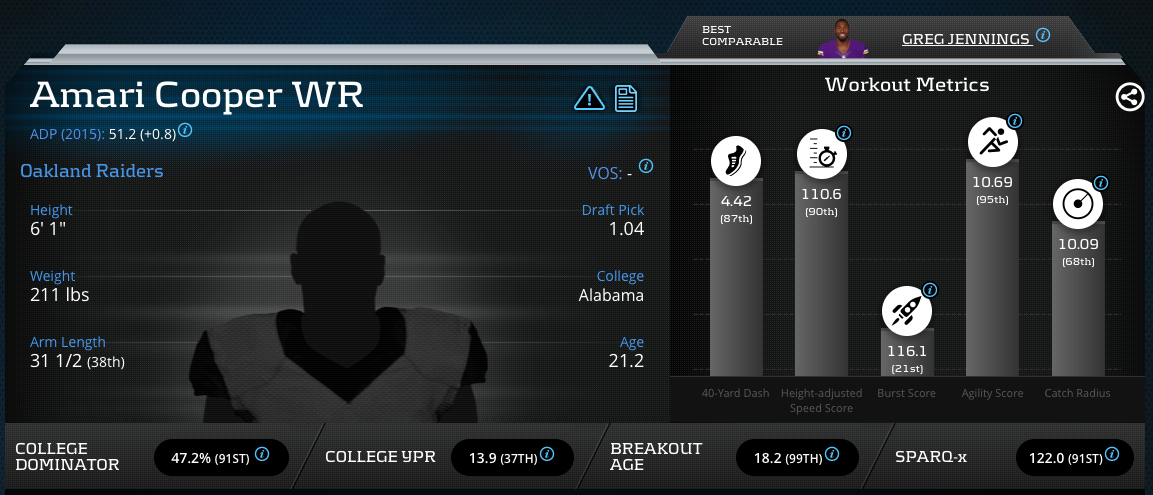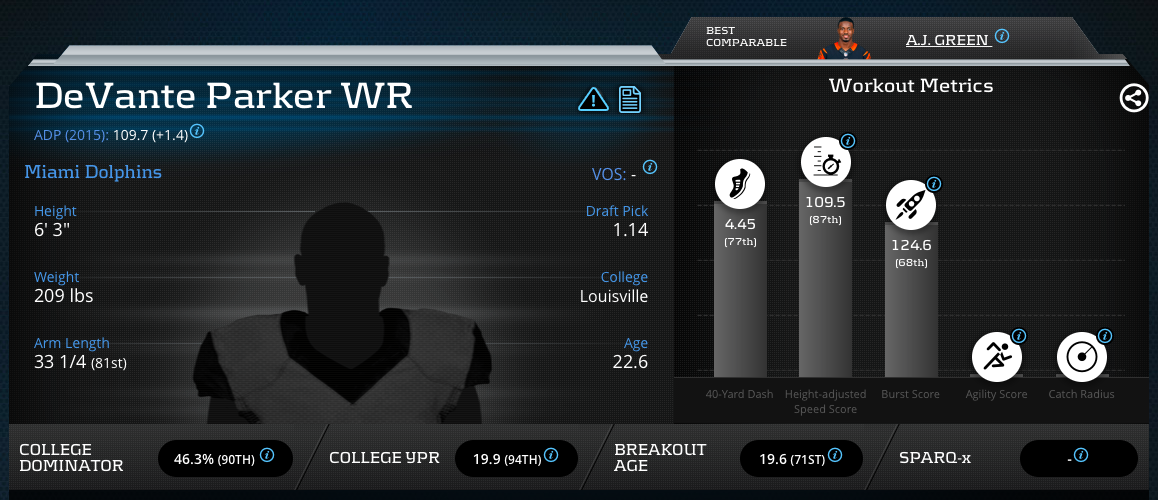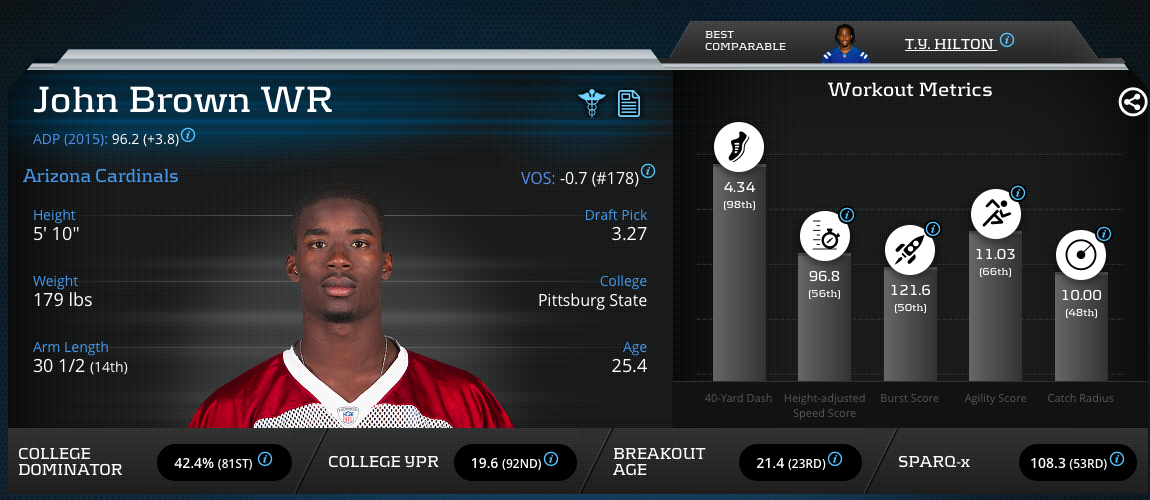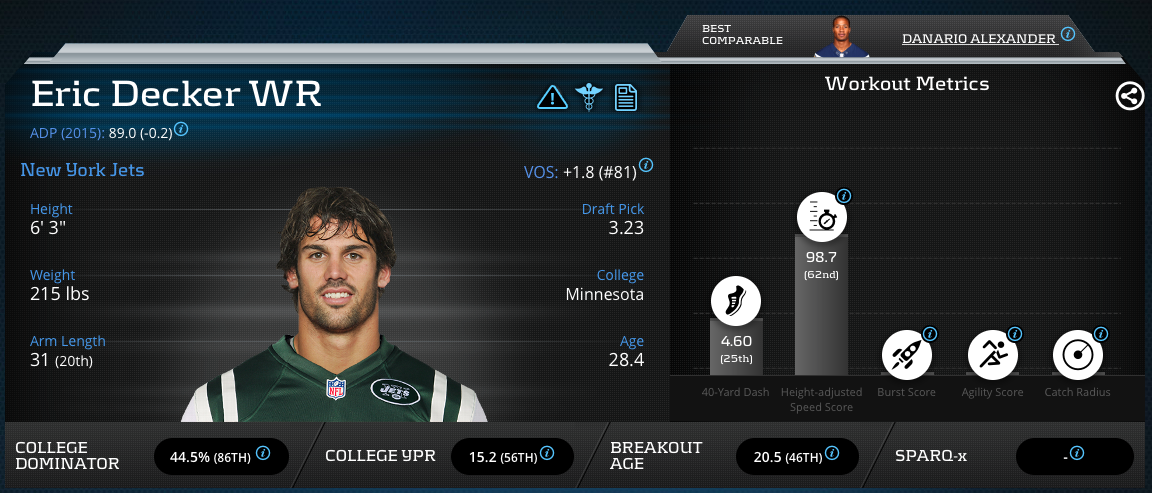Normally an argument over which wide receiver to take focuses on pure physical and athletic qualities, and what role the player has in his offense. Often lost in arguments over which wide receiver we should take, is the focus on quarterback competency, and to a lesser extent offensive scheme. Having a quarterback who can elevate the talent around him is a major factor in determining a receivers ceiling and floor in fantasy. Additionally, the offensive scheme is about as equally a major factor as the quarterback is for a receiver.
While last year offered plenty of teams first wide receiver options being drafted as a WR2 for fantasy purposes, even more teams second option receivers were valued as a WR3 at their highest. One such example of a perceived value pick at WR last year was Sammy Watkins while Emmanuel Sanders was a highly contested pick going right before Watkins. Watkins finished as WR33 while Sanders finished as WR7 for any drafter bold enough to take him right ahead of Watkins. Improving his QB from Ben Roethlisberger to Peyton Manning, and staying in a heavy passing attack helped Sanders make such an amazing jump in both real and fantasy football.
Soaring to Value
The list below airs out the difference in bad QB’s first option and good QB’s second option wide receiver through a comparison of 2014 ADP and PPR fantasy points per game rank:
Overall the No. 1 receivers impacted negatively by scheme or quarterback displayed that they were merely worth the price they were drafted for as they outperformed their draft position by an average of +0.17 in 2014, and that is boosted by the always underrated Anquan Boldin. Even as a rookie, Sammy Watkins showed no immunity to this problem while he was drafted later on in drafts due to his rookie status.
On the other hand, while these players might be their teams No. 2 at receiver, they showed that between offensive scheme and good quarterbacking they can offer superior value to No. 1 receivers who are hampered by quarterbacking and/or offensive scheme as they outperformed their draft position by an average of +2.9 in 2014. Their average outperformance is +2.73 more than the number 1s listed above, which is a major difference maker.
Tentative Target Shares
Kelvin Benjamin: Sophomore Slump
Only a year ago, the question begged how can you keep such a huge athlete (only his HaSS is athletically impressive) off the field when the Panthers selected Kelvin Benjamin. A year later, the answer might have appeared in the near as big and far more athletic, Devin Funchess. Last year alone, Benjamin was off the field for 10 percent of the snaps already, which is a lot for a number 1, and made him 35th in terms of snaps played percentage wise for a receiver. To top that off, the Panthers were barely a top 20 pass play team last year, which means Benjamin needs to be on he field at all times, and take full advantage of every opportunity that he gets.
Opportunity, if there is one thing Kelvin Benjamin had more than anyone it was that. The problem with the opportunity Benjamin had is that he made an abysmal use of it, which was similar to his play while in college as evidenced from his dominator rating. While he had the fifth most targets with over 9 per game, he only caught half of those to amount to 73 catches, which was 23rd most last year. He turned his mega opportunity into the No. 19 most fantasy points per game, bare minimum output given such opportunity. With all this inefficiency, opportunity is just what Benjamin needs to remain consistently fantasy relevant.
The Panthers will remain a run first team, but they have Greg Olsen and now Devin Funchess to take away from Benjamin’s opportunity in the passing game. With Benjamin’s current ADP at 17, there is no room for error in his game. He must become more efficient and remain the No. 1 target in the Carolina offense. Unfortunately, Benjamin’s low College Dominator Rating paired with an old breakout age leads to believe that he should not be very successful dominating in the league; add a pathetically low catch radius for a player with his size (6-5, 240-pounds), and efficiency cannot be assumed to improve. Surprisingly, Benjamin is being drafted before other team No. 1 wide receivers such as Allen Robinson, Jeremy Maclin, and Brandon Marshall. All of these players while probably not finishing ahead of Benjamin should offer more value at their picks than him and provide more good reason to pass on the big target.
Sammy Watkins: Continuing Disappointment
I admit it, I loved Sammy Watkins at Clemson, and I loved him coming out of Clemson last year, but I finally am saying enough is enough. Before getting into all the negatives about Sammy, let me get one positive out of the way. E.J. Manuel is officially third string QB for the Bills at least temporarily. It took Kyle Orton and his middle of the road quarterbacking stats to salvage Sammy Watkins last year. So for anyone hoping for a Sammy breakout, here is to the one thing you have going for you, the benching of E.J. Manuel. Still do not expect much from the plethora of backups known as the Bills quarterback options.
Like Kelvin Benjamin, the NFL Scouting Combine exposed Sammy Watkins as not the uber-athlete that he was touted to be during his days Clemson. But unlike Benjamin, Watkins does have speed to burn started dominating at the college level at an early age (18-years old). Last year Watkins was the 29th receiver taken while finishing as No. 33 fantasy receiver, essentially matching the output implied by his 2014 fantasy draft position. Now he is the No. 20 drafted receiver, 9 spots ahead of last year’s draft capital investment, and 13 spots ahead of where he finished last year.
Sammy Watkins is also transitioning from an offense with the 14th most passing plays to that with the 25th most passing plays. In that offense, Eric Decker finished as WR26, 7 spots ahead of Watkins, but he did so receiving 14 less targets while being a far more efficient receiver in terms of fantasy points per target with 1.76 compared to 1.55 for Watkins. While these reasons alone are enough to question Watkins price, these are far from the most disturbing arguments to make against Watkins.
Evaluating Sammy Watkins independent of his substandard supporting cast is challenging. While he had the 29th highest target rate, his efficiency was disappointing. Watkins’ 65 receptions ranked him 35th among receivers with his near 51-percent catch rate ranking him No. 86 in the NFL. His red zone target rate of 16.7-percent was bad enough to be No. 51 among receivers, and his red zone catch rate of 41.7-percent was near even worse at No. 70 among receivers. While all these leave room for improvement, there is not much hope for that in a more run centric offense. Watkins’ performance last year also lends a warning to a rookie receiver this year.
Amari Cooper: Black Hole of Rookie Value
Enter that rookie receiver, Amari Cooper. Yes, Cooper might be a more polished receiver and better athlete than Watkins, but that does not guarantee him immunity to No. 1 receiver troubles. That being said, Cooper dominated from the same young age as Watkins, and put up a 47.1-percent College Dominator Rating to put him in the 91st-percentile; however, Cooper did this due to a plethora of passes coming his way as shown by his low 13.9 yards per reception, which placed him in the 37th-percentile. Because they are not necessarily the most comparable receivers you may find yourself asking why the comparison between the two is being made to such an extent. The leading receiver for Oakland put up a 75-885-7 stat line that was good for 198 points at 12.4 points per game, which would rank him No. 33 among wide receivers. Interestingly, Sammy Watkins put up a similar stat line in his rookie year.
While Oakland threw the fourth most passes last year, it would be somewhat foolish to believe that they will throw as much this year with the very inefficient Derek Carr at quarterback. Last year, Carr posted a 58.1 completion percentage with a 5.4 yards per attempt, respectively those were good for No. 33 and No. 38 among quarterbacks. His 2.9 air yards per attempt are better at 27th among quarterbacks and are helped out based on him throwing the 11th most deep balls even though he completed a horrible 23.7-percent of them. If Carr continues to fail on throws that go towards his receivers and instead continues to check down as his yards per attempt show then successful targets will go more toward backs and tight ends instead of Amari Cooper.
Unfortunately for Cooper, his athletic strength does not necessarily mesh with Carr’s passing strength. Carr had a top-10 red zone completion percentage, but Cooper is in the 21st-percentile for burst score while boasting only a 34-inch vertical jump. Winning jump balls in the red zone will not be Amari Cooper‘s calling card while that would help him with Carr as his quarterback. Right now Cooper is being selected right between Benjamin and Watkins as WR18, which puts him way ahead of what the “Oakland WR1” performed at last year. Is Cooper a better receiver than Oakland’s revolving door of No. 1 receivers last year, yes; however, be careful in what you are expecting of him.
More Slices of a Bigger Pie
DeVante Parker: No. 2 Becomes No. 1
While Amari Cooper may be an overpriced rookie, his rookie counterpart DeVante Parker provides potentially very strong value based on his current price. While it would take massive hyperbole to say any rookie coming in to the league can take the fantasy world by storm the way Odell Beckham did last year, Parker offers value while being drafted as the 40th WR. Much like Beckham entered a high-volume offense that ran the 12th most plays in the NFL in 2013, Parker enters into an offense that threw 9th most passes in the league in 2014. The Dolphins threw the 5th most red zone passes with Tannehill completing 59.6-percent of those passes, which was good for 11th best among quarterbacks. As Ryan Tannehill‘s biggest WR, Parker will be the clear-cut No. 1 red zone weapon.
At Louisville, DeVante Parker ran through his competition like they were back in high school while posting a dominator rating in the 90th percentile and maintaining a yards per reception in the 94th-percentile. While Parker offers tremendous 4.45 speed his 109.5 HaSS is even better placing him in the 87th-percentile. Parker, like his closest comparable player A.J. Green, features a full and complete route inventory at his disposal. This ability aligns with Tannehill’s strengths as he is better throwing to more intermediate routes as evidenced from his 6.9 yards per attempt and 34-percent deep ball completion percentage.
While the current foot injury is currently tempering DeVante Parker‘s 109.7 ADP in MyFantasyLeague.com money leagues. Entering into a top-10 pass attempt offense with a good quarterback is a major positive for Parker as it raises both his floor and ceiling for fantasy production. If Parker is healthy throughout 2015, he has a chance to jump up the depth chart and become his teams leading receiver. Parker, like Odell Beckham, is coming back from an early injury, and is the most athletic receiver on his team. He demonstrates true it receiver qualities while being surrounded by other receivers like Jarvis Landry and Kenny Stills who fit into very specific supporting roles.
John Brown: T.Y. Hilton West
Yes, John Brown reminds of T.Y. Hilton, his closest comparable player on PlayerProfiler.com. There is absolutely nothing wrong with this comparison as the two are similar players; however, it is hard to believe that he will just go off for over 1300 yards on over 80 catches as a featured receiver like T.Y. did this past year. Instead, lets compare him to another receiver that Bruce Arians has coached, Mike Wallace. Wallace has become a consistent 60-70 catch receiver, and that is exactly what Brown could become this year while he earns a bigger role in Arians offense.
When Mike Wallace broke out in his sophomore NFL season he went 60-1257-10, an impressive stat line itself and even more impressive for a deep ball specialist role. While Carson Palmer was healthy for 6 games he threw 29 deep balls putting him on pace to throw almost 80 deep balls over a 16 game season. 80 deep balls is a lot; former Wallace QB, Ben Roethlisberger, led the league in deep ball attempts last year with 73, and if Palmer stays healthy and throws 80 passes further than 20 yards in 2015, that equates to one extra deep attempt every other game, which enhances Brown’s fantasy ceiling. Palmer only connected on 37.9-percent of his deep balls last year, but if he maintains or improves that then he will complete at least 30 of those deep attempts which gives Brown plenty of opportunity to excel.
Outside of having a healthy Carson Palmer helping him, John Brown can help himself by earning more snaps than the only 64.1-percent that he earned last year, which put him No. 81 among wide receivers. Even in that reduced amount of playing time, Brown took advantage while posting the 11th highest target hog rate at 16.0-percent meaning that he saw a target come his way almost every fifth play that he was on the field for. Because of limited playing time and missing three games, Brown saw 80 targets come his way; with Palmer and himself healthy it is not unlikely that he sees over 100 targets and is able to capitalize on them making himself a great value as late as he is going.
While Brown’s floor is potentially an early career Mike Wallace his ceiling is that of T.Y. Hilton from just last year. Brown is just as athletic as Floyd, and commanded a higher hog rate and catch rate than Floyd in 2014. Floyd and Brown may be fighting for similar roles, but only Brown has the ability to ascend to Cardinals’ No. 1 wide receiver chair and unseat the Larry Fitzgerald like Hilton usurped Reggie Wayne in Indianapolis.
Eric Decker: Fitzmagical Value (Puncher’s Chance)
Never has one punch potentially changed both an offense and an article so quickly. While Jay Cutler is no Peyton Manning, this article nearly featured Brandon Marshall in the wide receiver to avoid section. Now, not only is Marshall valuable for fantasy teams, but also is Eric Decker valuable with Ryan Fitzpatrick running Chan Gailey’s unique offense. While Decker suffered the effects of leaving a Peyton Manning-led passing oriented offense for a Geno Smith lead running oriented offense, he still managed to provide good value to his fantasy owners. To say that changing from Smith to Fitzpatrick is a small boost would be an understatement as Smith had the 31st ranked passer rating, No. 32 in yards per attempt, and No. 30 in completion percentage. Meanwhile, Fitzpatrick was the NFL’s 9th rated passer and finished the season No. 5 in yards per attempt.
With Ryan Fitzpatrick as his QB this year, Decker provides good value as the No. 43 receiver off the board. As we saw last year in Houston, Fitzpatrick has no problem equally targeting both starting receivers while DeAndre Hopkins received 92 targets, Andre Johnson saw 97 targets when Fitzmagic played. Finally, while previously playing under Gailey, Fitzpatrick helped lead Steve Johnson to three consecutive 1000-yard seasons.
Although he saw a dip in many categories with Geno Smith as his QB, Eric Decker actually had a relatively efficient 2014 season. He converted his 114 targets into the 21st most catches making 74 catches at a 64.9-percent catch rate percent that was good for the 26th best catch rate among receivers. Even more impressive than his standard catch rate was his contested catch rate of 91.7-percent, which was best among receivers. One area of the field that is highly contested is the red zone where Decker posted a 60-percent catch rate, which was No. 28 among NFL wide receivers. While he was able to make nine red zone catches, which was 14th best among receivers, he did so on a relatively low 20.3-percent red zone target share, which was 33rd among receivers. In addition to the low red zone target share, Decker was on the field an abnormally small amount of time for a team’s leading receiver playing only 84.8-percent of snaps. Forty-nine other wide receivers played a higher percent of their team’s snaps, and even as a No. 2 receiver Decker should see a higher snap share this season.
While Brandon Marshall may be a phenomenal athletic specimen, he has showed some signs of aging. AlthoughEric Decker may never truly overtake him for the No. 1 role this year, this situation has a good chance to be 1A and 1B receiving situation similar to the way Decker played alongside Demaryius Thomas in Denver when Decker finished as the No. 12 WR while Thomas finished as the No. 4 WR. Although it may only be Decker-lite compared to Denver Decker, he is still in his prime while Marshall is in his 30s.
Conclusion
Rather, an efficient No. 2 receiver paired with an elite quarterback is typically preferable to a No. 1 wide receiver paired with a sub-par quarterback. In addition to their roles as their teams second option, all of these receivers have the ability to possibly become their teams first option. Ricky Bobby famously stated, “if you are not first, you’re last.” But in fantasy football, No. 2 wide receivers are some of the best bargains in the game.

